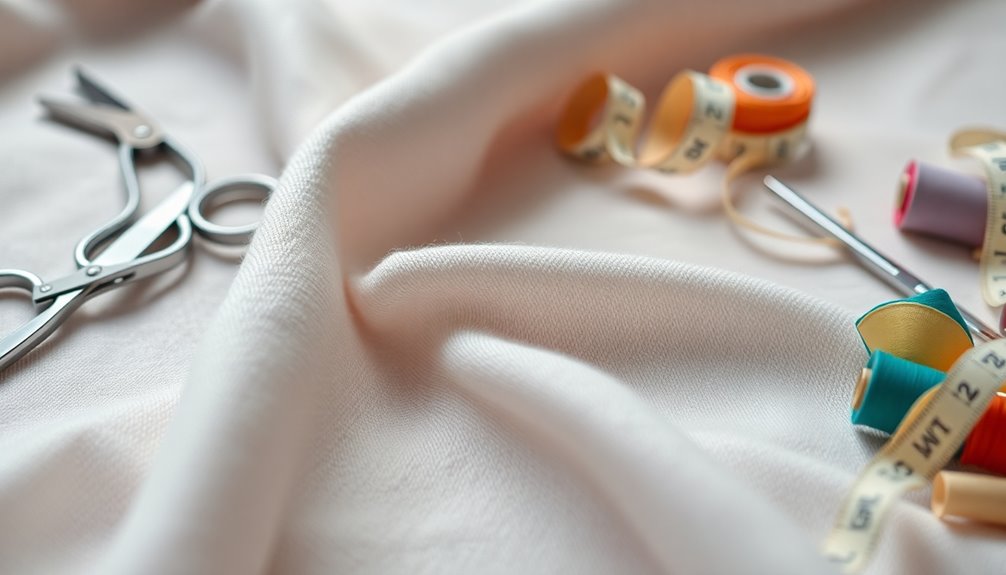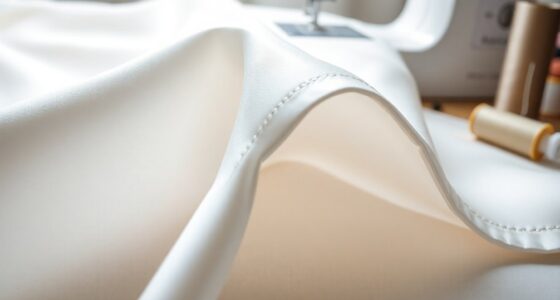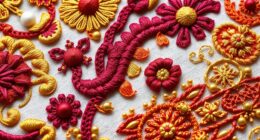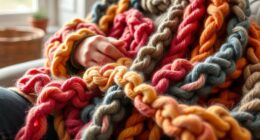Nap in sewing refers to the raised, fuzzy surface on certain fabrics, formed by the alignment of fibers. It impacts texture and how light interacts with the fabric, making one side feel different from the other. Napped fabrics can show varying shades based on the nap direction, so you'll want to cut and sew with this in mind to achieve a polished look. Keep going to discover essential tips for working effectively with these unique fabrics!
Key Takeaways
- Nap in sewing refers to the raised, fuzzy surface of certain fabrics, influencing texture and appearance.
- The direction of the nap affects light reflection, making fabrics appear different based on how they are brushed.
- Consistent nap orientation is crucial for a polished look; all pattern pieces should be cut in the same direction.
- Napped fabrics, like velvet and corduroy, require gentle pressing techniques to avoid damaging the raised fibers.
- Marking the nap direction helps prevent cutting confusion and ensures proper alignment during sewing.
Understanding Fabric Nap
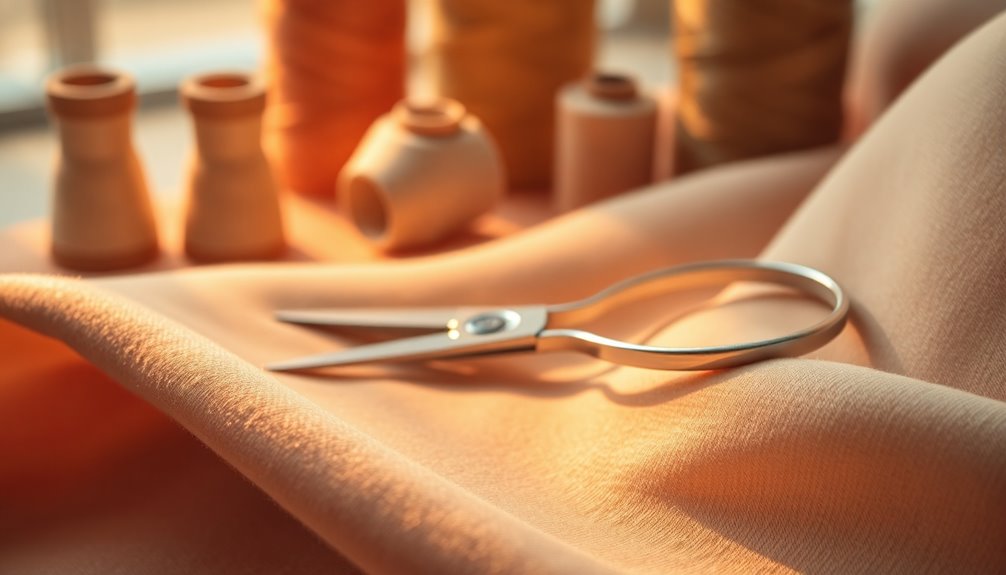
Understanding fabric nap is essential for any sewing project involving napped materials. Fabric nap refers to the raised, fuzzy surface created by the alignment of fibers, influencing texture and light reflection.
When working with napped fabrics like velvet, corduroy, or moleskin, you need to cut the fabric with the nap direction facing the same way for all pieces. This consistency avoids discrepancies in color and texture in your finished garment. Using a "with nap" layout is often necessary, requiring more fabric than you might expect.
Additionally, when pressing, be gentle to prevent crushing the fibers and altering the intended texture. Mastering these techniques guarantees your sewing patterns come out beautifully, showcasing the unique qualities of napped fabrics. Moreover, understanding the construction of various garment elements, such as collars and sleeves, is crucial in achieving a polished finish. For instance, when working with a yoke, it’s important to ensure it fits seamlessly into the overall design, enhancing both the structure and aesthetics of the piece. So, what is a yoke in sewing? It is a fitted piece, often at the shoulders or the back, that adds shape and support to the garment, contributing to a tailored look.
Characteristics of Napped Fabrics
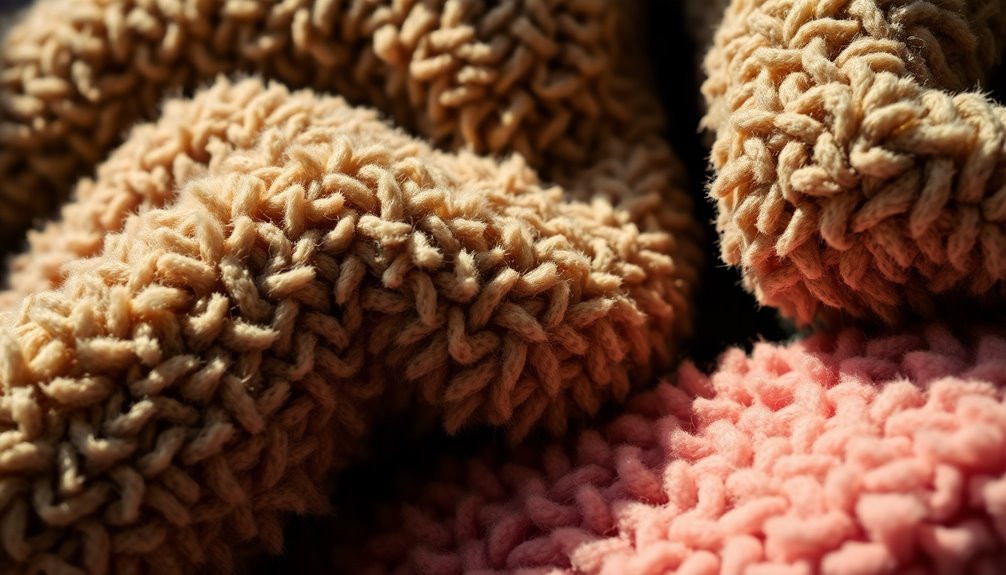
Napped fabrics like velvet and corduroy have unique texture variations that can change how light reflects off their surfaces.
You'll need to pay close attention to the cutting direction, as it's essential for maintaining a uniform appearance throughout your project.
Understanding these characteristics will help you achieve the best results when working with these luxurious materials.
Fabric Texture Variations
When exploring fabric texture variations, you'll find that napped fabrics offer a unique tactile experience that sets them apart from non-napped materials.
The nap refers to the raised, fuzzy surface of fabrics like velvet and corduroy, enhancing their texture and appearance. The direction of the nap plays an essential role; it affects how light interacts with the fabric, resulting in different shades and sheens depending on whether you brush with or against the nap.
For consistent texture in your project, you'll need to cut and layout all pattern pieces in the same direction.
Remember to press napped fabrics gently from the reverse side to preserve their texture, ensuring your finished garment looks its best.
Light Reflection Effects
The unique texture variations found in napped fabrics greatly impact how light interacts with their surfaces. When working with napped fabrics like velvet or corduroy, you'll notice that the direction of the nap markedly affects how light reflects off the material.
Depending on the angle, these fabrics can appear darker when the nap is brushed one way and lighter when brushed the opposite direction. This creates a striking visual effect that enhances their luxurious appeal.
As you cut and sew your projects, maintaining a consistent nap orientation is vital, as differing directions can lead to inconsistencies in color and appearance. Paying attention to how the nap interacts with light guarantees your finished garments look their best.
Cutting Direction Importance
To achieve a polished look in your sewing projects, it's crucial to take into account the cutting direction of napped fabrics. All your pattern pieces must be oriented in the same direction to maintain a consistent appearance and prevent color discrepancies caused by light reflection.
Use a "with nap" layout, which may require extra fabric for proper cutting. When you cut napped fabrics with the nap going down, it enhances comfort and minimizes the risk of snagging on surfaces.
Before you cut, always test the nap direction by brushing the fabric in different ways to spot any color or texture changes. Mixing cutting directions can lead to visible differences, undermining the quality of your finished garment.
Importance of Nap Direction
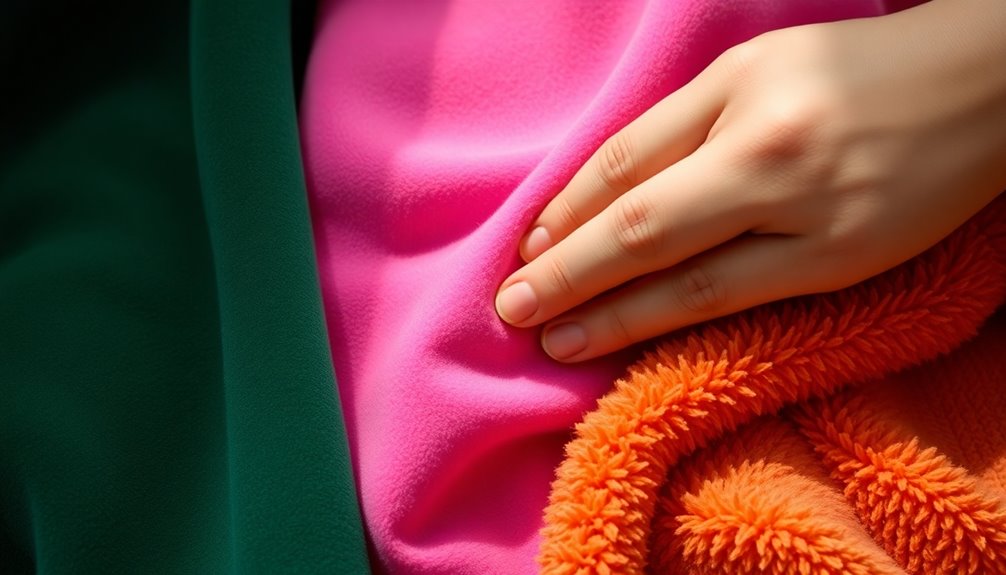
Understanding the importance of nap direction is essential for achieving a polished and professional look in your sewing projects. When working with napped fabrics, cutting the pattern pieces with all pieces facing the same direction guarantees a consistent appearance. Here's a quick reference:
| Action | Effect | Recommendation |
|---|---|---|
| Cut in the wrong direction | Mismatched shades | Test nap direction first |
| Cut with nap direction | Uniform color/texture | Use extra fabric if necessary |
| Mark fabric orientation | Prevent confusion | Use pins or tailor's chalk |
Identifying Fabrics With Nap
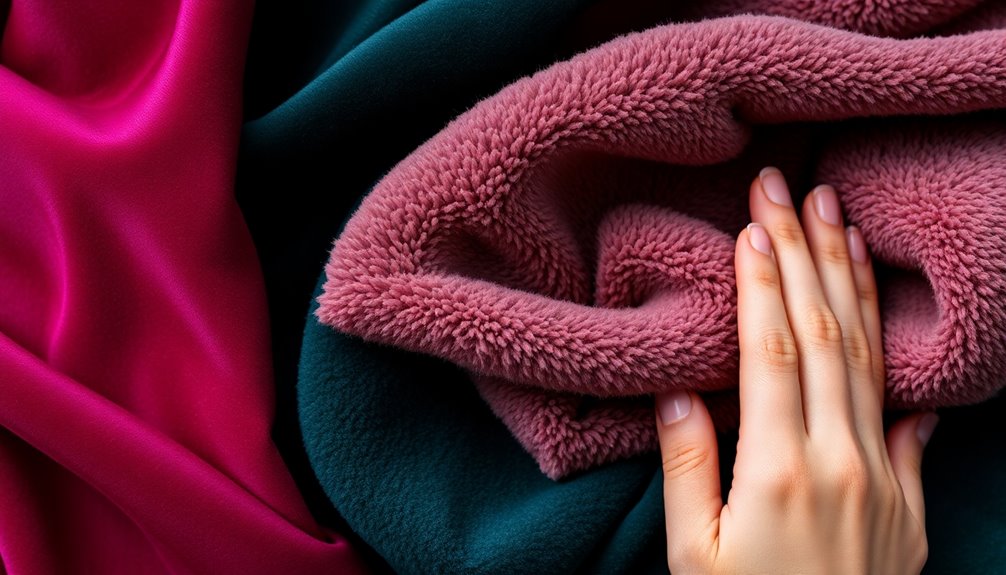
When you're identifying fabrics with nap, start by recognizing the texture; running your hand across the surface will reveal smoother and rougher sides.
Don't forget to look at any prints—one-directional designs often signal the presence of nap.
Testing the fabric's directionality by flipping samples can help you see how the color and texture change, ensuring you make the right choice before cutting.
Recognizing Napped Textures
How can you tell if a fabric has a nap? Start by feeling the surface of the fabric. Napped fabrics, like velvet or corduroy, have a raised, fuzzy texture that's noticeable. Brush the fabric in different directions with your hand; you'll see and feel changes in sheen and color, indicating the nap direction. Here's a quick reference:
| Fabric Type | Nap Characteristics | Visual Cues |
|---|---|---|
| Velvet | Soft, plush surface | Shiny when brushed with nap |
| Corduroy | Ribbed, textured | Color changes when brushed |
| Faux Fur | Thick, fuzzy | Flattens when brushed against |
| Cotton Broadcloth | Smooth, non-napped | No color change when brushed |
| Suede | Soft, matte finish | Slight sheen when brushed |
Identifying the nap helps guarantee your sewing pattern pieces align correctly for a consistent look.
Testing Fabric Directionality
What's the best way to determine the directionality of a napped fabric? Start by gently rubbing the surface in both directions.
You'll notice differences in texture and sheen, which indicate the nap direction. Look closely for variations in color when brushing the fabric; these can greatly affect how your garment looks.
Once you identify the nap direction, mark it on the fabric with tailor's chalk or fabric-safe pins. This helps guarantee all pattern pieces are cut consistently, maintaining a uniform appearance in your project.
Cutting Techniques for Napped Fabrics
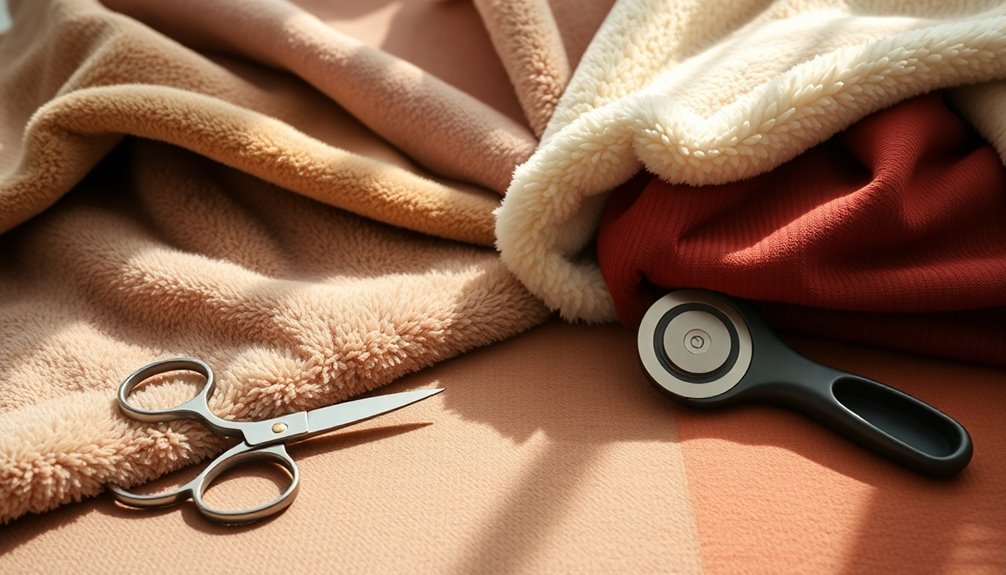
Cutting napped fabrics requires careful attention to detail to guarantee your finished garment looks polished and consistent. Start by ensuring all pattern pieces align with the nap direction; this helps maintain a uniform appearance throughout.
Use a "with nap" cutting layout, making sure all pieces face the same direction to avoid noticeable color differences. Cutting in a single layer is essential to prevent shifting, which can easily occur with napped materials.
To minimize fabric waste, avoid cutting pieces in opposite directions, as this can create discrepancies in shade and texture. Finally, don't skimp on pinning; use ample pins to secure the fabric and maintain alignment during the cutting process, ensuring accuracy and consistency.
Sewing With Napped Fabrics
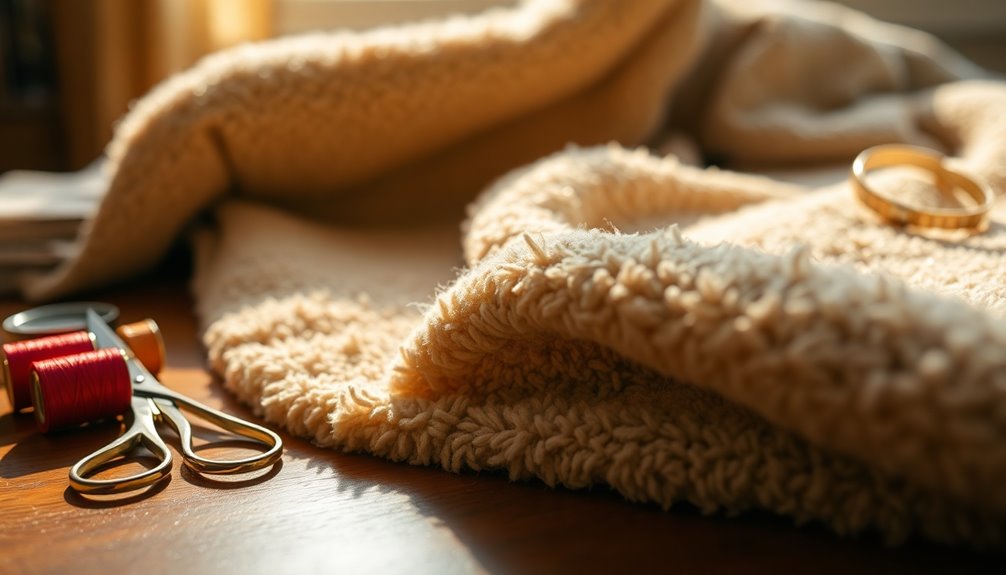
When you're sewing with napped fabrics like velvet or corduroy, identifying the fabric's direction is essential for a polished look.
Make sure you use the right cutting layout, as all pieces need to be cut with the nap facing the same way.
Also, remember to press carefully to avoid crushing the fabric's texture.
Fabric Identification Techniques
Napped fabrics, like velvet and corduroy, feature a distinctive raised, fuzzy surface that can dramatically shift in texture and color depending on how you stroke it.
To identify these fabrics, it's crucial to test the direction of the nap. Rubbing the fabric in different directions reveals changes in sheen and color, helping you determine how to cut your pattern pieces.
Always make certain that all pieces are cut with the nap going in the same direction to prevent discrepancies in your final garment. Mark the nap direction with tailor's chalk for clarity.
Also, check the pattern layout diagrams, as they often specify if you should use the fabric "with nap" or "without nap," which affects your fabric requirements.
Cutting Layout Considerations
To achieve the best results with napped fabrics, you need to pay close attention to your cutting layout. Always orient all pattern pieces in the same direction to prevent color discrepancies and guarantee a consistent look in your finished garment.
Remember, a "with nap" cutting layout requires more fabric, often leading to increased fabric waste. To minimize shifting, cut your napped fabric with the right side up, maintaining its texture and appearance.
Pinning is essential, but can be tricky due to the fabric's tendency to slide; using weights or basting can help keep everything aligned.
Finally, always check your pattern instructions for specific layouts that consider the directional characteristics of napped fabrics.
Pressing Methods for Nap
Although pressing napped fabrics requires extra care, you can achieve a beautiful finish by following a few key techniques.
Start by always pressing from the wrong side to protect the raised fibers.
Consider these methods:
- Use a terrycloth towel or silk organza as a pressing cloth to shield the nap.
- Minimize direct iron contact; gentle pressing techniques are best.
- Test the iron's temperature on fabric scraps to avoid damage.
- Stack fabric pieces to maintain nap integrity during pressing.
Pressing Techniques for Napped Fabrics
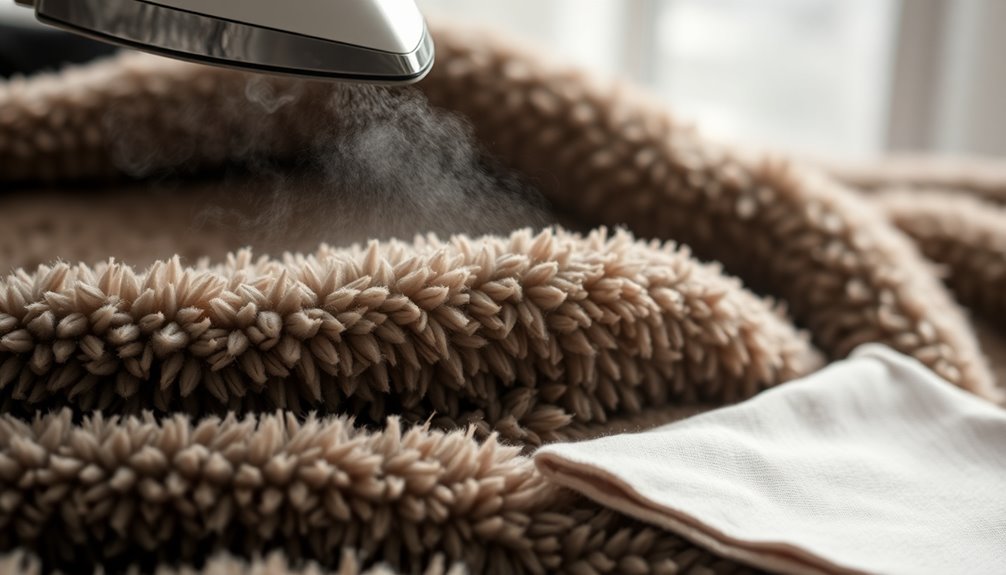
When working with napped fabrics, mastering the right pressing techniques is essential to preserve their unique texture.
Always press from the wrong side to avoid crushing the raised fibers and damaging the nap. Using a terrycloth towel underneath the fabric provides cushioning and protects the nap. A pressing cloth, like silk organza, can shield your fabric from direct heat while still allowing steam to penetrate.
Remember, light pressure is key; heavy pressing can flatten the nap and ruin its integrity. Stacking napped fabric pieces during pressing helps maintain consistent texture across your garment, ensuring each layer retains its plush feel.
Common Examples of Napped Fabrics
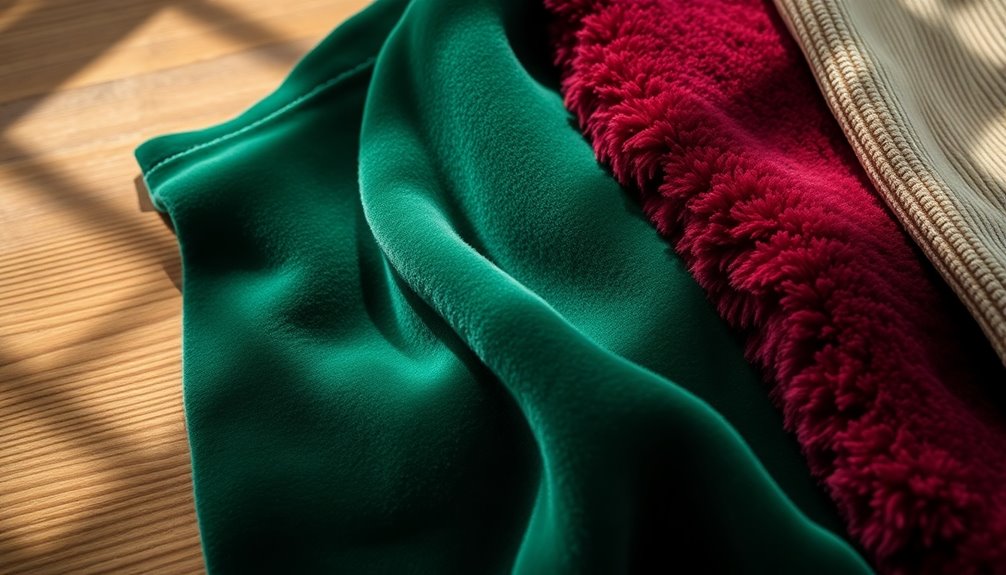
Napped fabrics add a unique texture and depth to your sewing projects, making them stand out.
You'll find that these fabrics not only look great but also feel amazing.
Here are some common examples of napped fabrics you might want to contemplate:
- Velvet: Known for its luxurious texture and sheen, perfect for formal wear and upholstery.
- Corduroy: Features distinct ridges, offering softness ideal for casual clothing and home textiles.
- Fake Fur: Mimics real fur and provides warmth, great for outerwear and accessories.
- Suede: A soft leather option, often used in clothing, footwear, and upholstery for its appealing touch.
Incorporating these napped fabrics can elevate your creations and give them a professional finish.
Tips for Working With Napped Fabrics
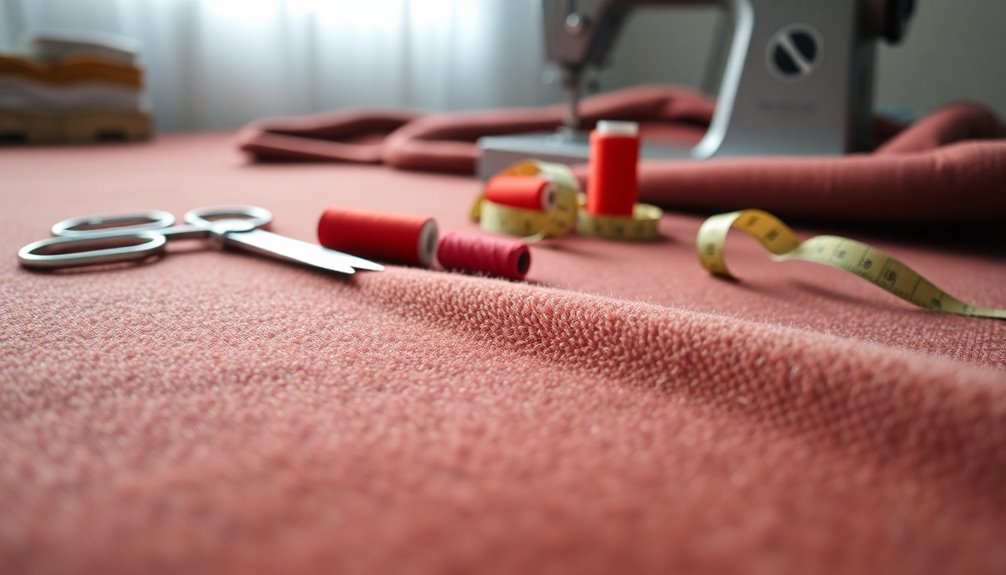
Working with napped fabrics can be a rewarding experience, but it requires some special considerations to get the best results.
Always cut all pattern pieces in the same direction to maintain a consistent nap and avoid uneven color or texture. Use a "with nap" cutting layout, as napped fabrics often need extra material. Before cutting, test the nap direction by rubbing a small section to check for color variations.
When sewing, pinning and basting can be tricky, so make sure proper alignment to prevent slippage.
Finally, when pressing seams, do so from the reverse side and use a pressing cloth to protect the nap and prevent crushing the fibers.
These tips will help you achieve a polished finish.
Resources for Further Learning
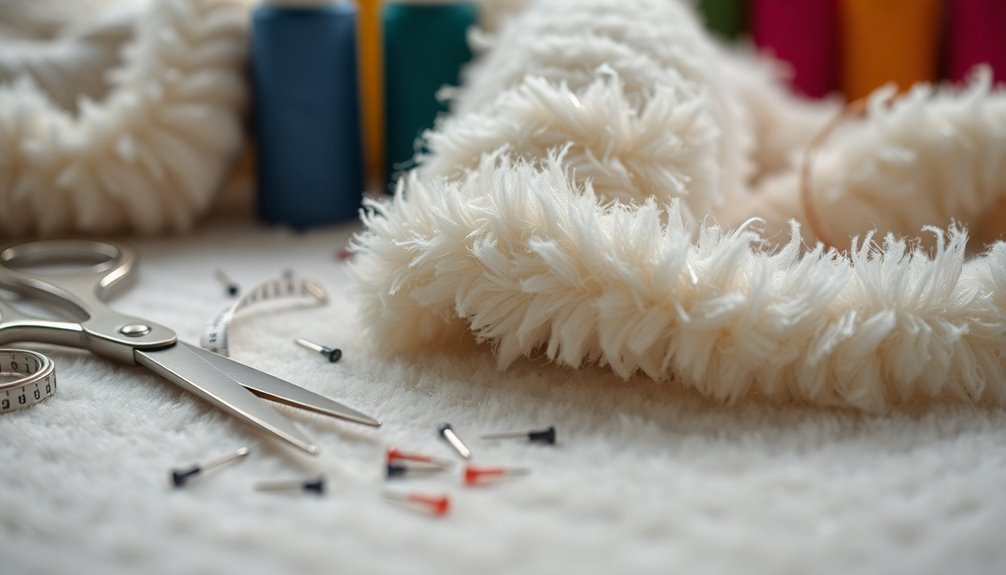
To deepen your understanding of sewing with napped fabrics, you can explore several valuable resources. Here's what's important to know:
- The Sewing Directory offers hundreds of sewing projects and expert guides specifically for napped fabrics.
- Check out related articles like the Liberty Fabric Guide and tutorials for viscose and canvas, which help you understand different materials.
- Access step-by-step tutorials that cover basic sewing tools and techniques tailored for napped fabrics.
- Engage with the community through comments and share your experiences, fostering collaborative learning about fabric characteristics and sewing challenges.
For specific inquiries, don't hesitate to reach out via email for personalized assistance.
These resources can greatly enhance your sewing skills and confidence with napped fabrics!
Frequently Asked Questions
How to Tell if Fabric Has a Nap?
To tell if fabric has a nap, rub your hand across the surface in both directions. If you notice a difference in texture or sheen, it likely has a nap.
Fabrics like velvet and corduroy usually exhibit this characteristic, while cotton broadcloth doesn't.
You can also flip a sample and see if the color or texture changes when brushed differently.
If you're unsure, check the fabric's description or tags for more information.
What Is the Definition of a Nap?
A nap refers to the raised, fuzzy surface of certain fabrics that can affect their texture and appearance.
You can notice this in materials like velvet and corduroy, where the fibers create a unique sheen.
The way light interacts with the nap can lead to color variations depending on the angle you view it from.
Understanding the nap is essential for maintaining a consistent look in your sewing projects.
Make sure to identify its direction!
What Is the Difference Between Fabric With Nap and Without Nap?
Imagine wrestling with a fabric that has a mind of its own!
Fabrics with nap, like velvet, shine differently depending on how you cut them, while smooth fabrics, like cotton, let you be free and wild with your cutting.
Napped fabrics demand attention, needing all pieces cut the same way to keep a consistent look, whereas non-napped fabrics can be arranged however you fancy.
You'll need extra material for napped fabrics—what a fun challenge!
What Is the Process of Napping Fabric?
Napping fabric involves raising fiber ends to create a soft, fuzzy texture. You can achieve this through methods like washing, fulling, or using an abrasive surface, such as sandpaper, to create a pile.
Originally, dried teasel pods were used for woolen cloth to enhance the texture.
Be careful during the napping process, as it can affect the fabric's appearance and feel, as well as its color absorption based on the nap direction.
Conclusion
In sewing, understanding nap is like traversing a forest; you need to follow the right path to avoid getting lost. By recognizing the direction and characteristics of napped fabrics, you can create projects that flow seamlessly, just like sunlight filtering through the trees. Remember to cut and press with care, ensuring your creations shine in their best light. Embrace the texture and warmth of napped fabrics, and let your skills blossom like a vibrant wildflower meadow.
